Small-Scale Monitoring for Large-Scale Impacts: Building Storm Resilience in the Newfound Lake Region
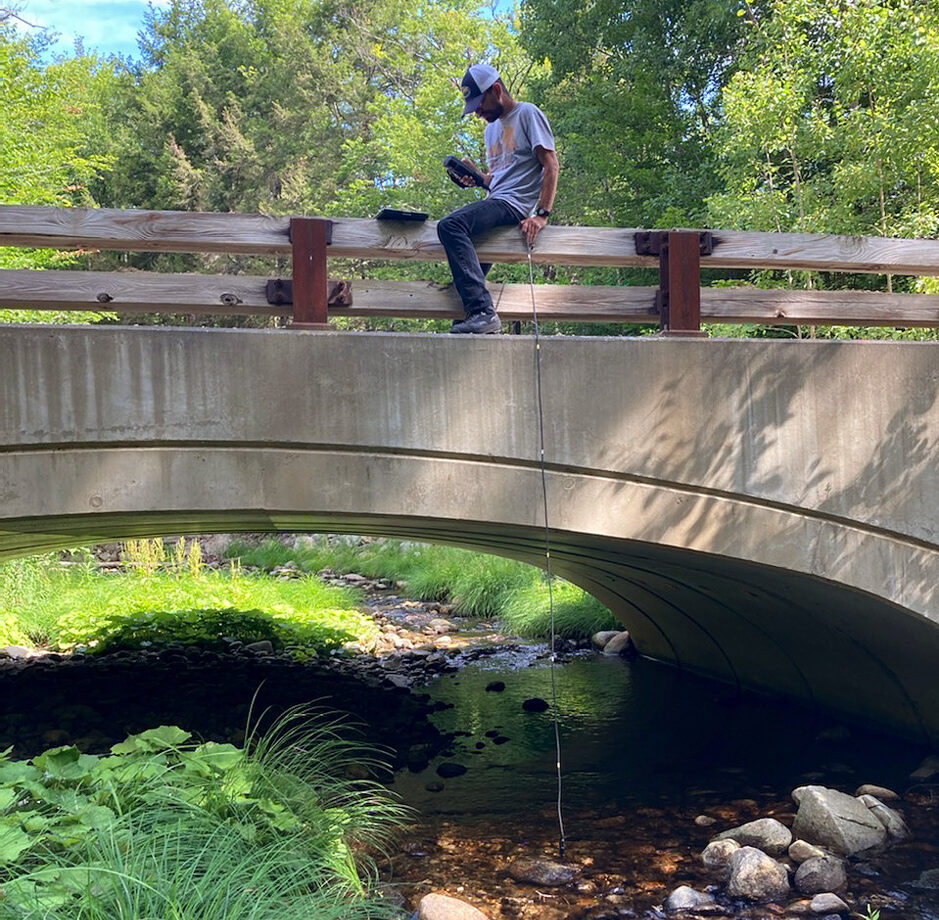 Monitoring Newfound Lake’s tributaries allows the NLRA to better understand how these systems are changing and helps to quantify the impact that development is having on water quality in Newfound Lake. (Credit: NLRA)
Monitoring Newfound Lake’s tributaries allows the NLRA to better understand how these systems are changing and helps to quantify the impact that development is having on water quality in Newfound Lake. (Credit: NLRA)
As many resource managers and conservation groups can attest, their work serves both the environment and the surrounding communities. Dynamic and healthy ecosystems can become center points for towns, cities, and entire regions—such is the case in the Newfound Lake Region, located in central New Hampshire. The Newfound Lake Region Association (NLRA) knows just how critical the preservation of the lake and surrounding watershed is for all members of the region. Paul Pellissier, the NLRA’s Conservation Program Manager, considers everyone living near Newfound Lake to be connected to the water. He explains, “You don’t have to be a million-dollar shorefront property owner be connected to the Lake. You could be working and living further out in the watershed, and your impacts are just as great as if you were living on the shore.”
Keeping those impacts in mind is particularly important for relatively intact systems with high water quality like Newfound Lake. Fortunately, management doesn’t have to focus so much on reviving the watershed; instead, the focus can be centered on small- and large-scale approaches to management that include the public. Pellissier states, “When I see what other lakes are having to do to manage invasives and claw back ecosystem function, I feel fortunate that our task, and large responsibility, is stewarding a relatively healthy ecosystem into the future.”
Public Outreach in the Newfound Lake Region
A large part of that stewardship involves citizen science and education initiatives that engage the local community. The NLRA works with people of all ages and backgrounds in their region. There’s an obvious reason to include young people, as they are the future, but it’s also about connecting the community to a resource that can be difficult to access. Newfound Lake has a large seasonal community, with many second homes along the shore and only a handful of public access points to the lake. “Getting folks that live in the watershed, especially kids, to experience Newfound Lake in order to better understand that what happens out in the watershed directly influences the health of the lake and is really important. Not only for stewarding the next generation of conservationists but also for the long-term protection of this shared resource,” Pellissier states.
Educational opportunities are vital for teaching the community about the importance of the system. Pellissier believes the human side of conservation to be critical, stating, “All conservation work needs to start from a place of education and getting people to come on board to what the mission of our organization is really about.” For the Newfound Lake Region, including the community in conservation means securing a future for the system. “You’re talking to someone who works with a nonprofit. Public support is kind of our bread and butter. If it wasn’t for the support of our community, we wouldn’t be able to do our work nearly as effectively as we do,” he says. He continues, “We’re fortunate, our community is very supportive in that way.”
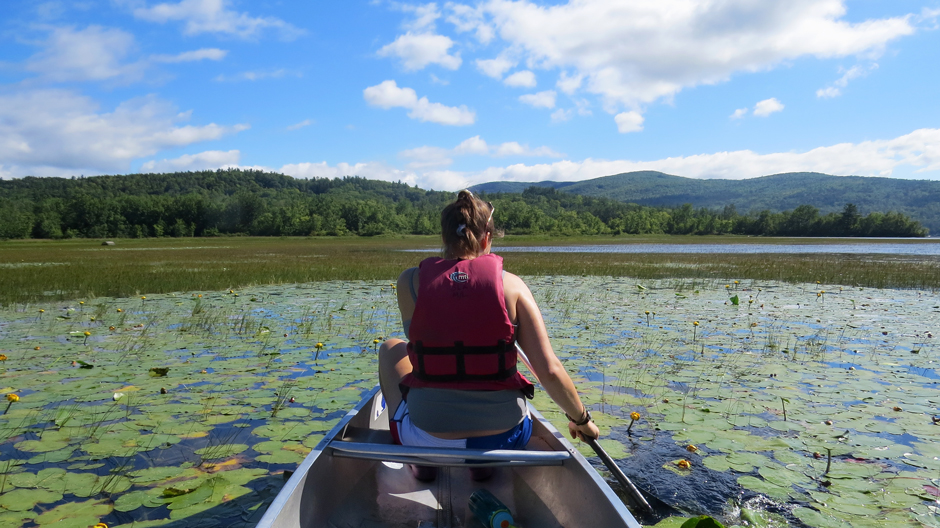
Twenty-four trained Weed Watcher volunteers took to Newfound Lake as part of the lake-wide Weed Stampede, surveying for invasive aquatic plants. During the two-day event, volunteers paddled 78.5 miles and surveyed over 60% of the lake’s near-shore area. (Credit: NLRA)
Conservation Approaches
Community support and cooperation are vital for the success of any conservation efforts, no matter how big or small. Groups like the NRLA rely heavily on volunteers to help gather data and protect the environment. Residents of the region have stepped up in Newfound Lake’s hour of need, and even those that consider Newfound their second home are invested in the ecosystem’s health and preservation. Newfound is considered an oligotrophic lake, meaning it is deep, clear and cold with low nutrient levels. As far as monitoring and conservation are concerned, Newfound’s characteristics lead to a unique approach to common problems.
Two of the top concerns for Newfound Lake are invasive species, particularly aquatic plants, and pollution from stormwater runoff. In order to protect against both of these variables, the NLRA has spent years building programs and developing standing in the community. Much of the organization’s work in defense against invasive species involves volunteer monitoring and prevention.
One of the major routes in which invasives are introduced is through hitchhiking. Boats traveling in nearby waterways may unintentionally stow invasive species on the exterior or interior parts of the boat. For that reason, the NLRA worked with statewide partner NH LAKES to bring the Lake Host program to Newfound. This program provides complimentary boat inspections and educates boaters on invasive species and proper boat care in between use. Since 2002, Lake Hosts have prevented 28 fragments of invasive plants from entering the ecosystem. While seemingly insignificant, the introduction of an invasive species like variable milfoil could harm the delicately balanced ecosystem already established. Milfoil is one of the greatest concerns for invasives in the region as it can be found in nearby lakes and rivers, explains Pellissier.
With that concern in mind, the NRLA also runs a Weed Watchers program and an annual Weed Stampede event. The Weed Watchers program is ongoing and trains volunteers to keep an eye out for variable milfoil and other aquatic invasive plants through monthly surveys. Similarly, the Weed Stampede program seeks out invasives by engaging residents in a two-day, lake-wide event. This past summer, the Weed Stampede program attracted 24 volunteers who paddled 78 miles and logged 81.5 hours of survey time looking for invasive species, Pellisier shares. Thanks to the hard work of volunteers this past summer, 94% of Newfound’s near-shore area was able to be surveyed, and no invasive species were found.
Keeping invasives out of Newfound is one of the primary ways the NLRA protects the ecosystem. Keeping the watershed healthy and maintaining ecological function makes it more resilient in the face of a changing climate.
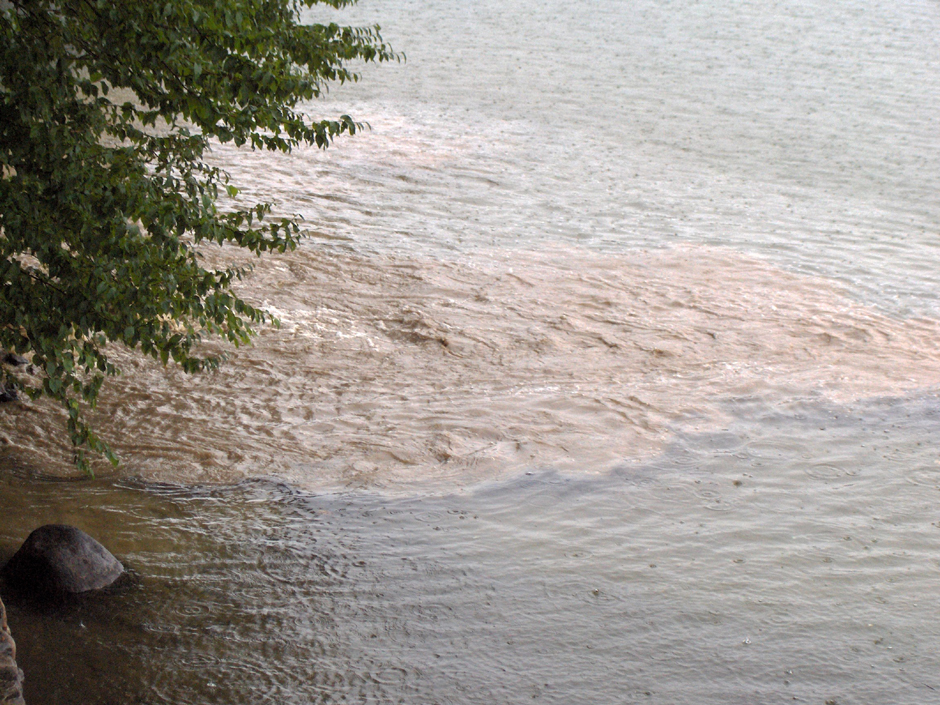
Sediment pollution from upland development entering Newfound Lake during a storm event. Stormwater carries sediment, pet waste, household chemicals, and nutrient pollution with it—therefore, negatively impacting ecosystem function. (Credit: NLRA)
Stormwater Response
Mitigating stormwater and the inevitable nutrient loading that follows is vital for systems like Newfound. Oligotrophic systems like Newfound Lake have lower nutrient levels, and nutrient loading following storm events can throw the system out of balance. Even smaller events can have an impact on the watershed’s health, which weakens it in the case of extreme weather events. Newfound Lake is surrounded by steep hills and mountains with highly erodible soil, meaning that in the case of snowmelt or rain, a great deal of sediments flood into the watershed below. Pellisier explains, “When the soils are saturated, an inch of rain throughout the watershed can raise the level of the lake by as much as 12 inches.”
With that in mind, the NLRA has created both small- and large-scale responses to stormwater threats. On the smaller side of things, the NLRA works to conduct stormwater assessments and propose some strategies that homeowners can use to protect the lake. Pellisier describes, “Part of the small-scale stormwater approach is looking at homeowner’s property and developing a suite of landscaping practices to limit the concentration of stormwater and increase infiltration on their property.” When deciding how to proceed with a property, vegetative buffers on the shoreline or stream bank are first and foremost. After that, the property owner and the NLRA decide on the best approach to manage runoff on that piece of land specifically. For example, when accessing the lake, creating a meandering path limits the amount of stormwater that reaches the lake as opposed to a straight path down a slope that funnels the water and causes erosion.
Pellissier highlights driveways, roads and roofs as some of the greatest sources of stormwater concentration. These contributors can be mitigated by ensuring that gutters are terminated into a dry well; ensuring driveways and roads are properly firmed, crowned, and maintained; and finally, ensuring infiltration trenches are deep enough to catch runoff. While the impacts of individuals may not have as large of an impact on the ecosystem as larger town-wide responses, individual actions help build the ecosystem’s resistance to environmental stressors. “By the numbers, it’s a different scale but if people feel like they’re engaged in protecting the watershed in their daily actions at home and that allows us to be more effective on the bigger stuff,” Pellissier highlights.
As it turns out, the “bigger stuff” has become increasingly relevant as extreme weather events become more frequent. Rebecca Hanson, Executive Director of the NLRA, explains, “As we see an increase in development and an increase in high-intensity storms, this threat is expected to grow. Maintaining, and improving, water quality in the lake remains our biggest challenge and our overarching objective. A healthy lake means we have a resilient ecosystem and prosperous local economy.”
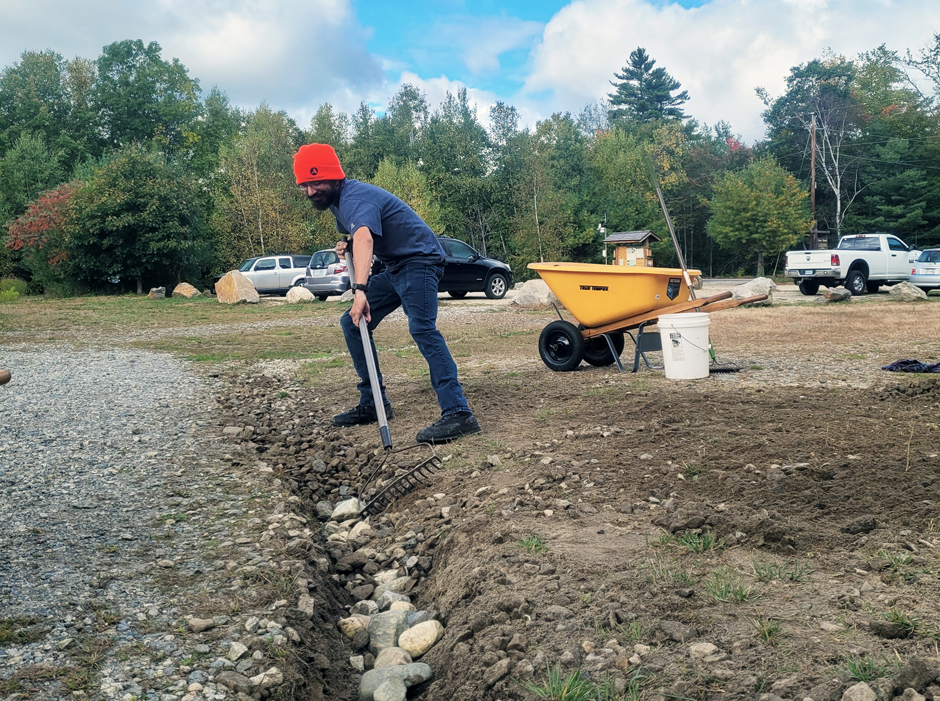
AmeriCorps Watershed Steward, Anthony Jaster, works to maintain an infiltration trench at the Grey Rock Conservation Area. Small-scale stormwater installations protect water quality by slowing down, capturing, and directing runoff away from water bodies to areas where it can infiltrate into the ground. (Credit: NLRA)
These large- and small-scale management strategies work in tandem to build up the watershed’s resilience to climate change and other environmental stressors. Hanson states, “By implementing stormwater management, we are actively encouraging water to infiltrate into the ground instead of running along the surface, picking up pollutants, causing more erosion, and depositing pollution into the lake.” This pollution can lead to nutrient loading in Newfound Lake and even algal blooms. A sudden increase in algal productivity in a system like Newfound would impact the availability of key nutrients and negatively affect native species. “We tackle stormwater both at the small scale—with homeowners and homeowner associations—and at the larger scale involving towns and state agencies,” Hanson comments. Working with both groups helps build the efficacy of the Newfound Lake Watershed Management Plan. Large-scale projects require intensive planning, heavy equipment, and coordinated effort—they also greatly impact the watershed’s health.
One large-scale project currently underway began as a result of a major storm event in 2019. The event washed out a stream bank, and now every storm brings more sediment and nutrient pollution to the tributaries below. The NLRA responded to the emergency at the request of local officials and is now working with the Town of Groton and three state agencies to repair the damages and prevent further pollution. If successful, the amount of runoff that reaches the nearby tributary will be massively reduced.
Conclusion
The success of small- and large-scale stormwater management plans works not only to repair current conditions but also embolden future conservation efforts. In regards to their current work in Groton, Hanson explains, “Careful and deliberate communication about this project also directs more folks towards our small-scale stormwater program. I believe it’s empowering for homeowners to direct energy and stewardship activities to their own property.”
Ultimately, Newfound Lake is a cornerstone of the surrounding community. In 2008 local students from Plymouth State University interviewed members of the community that grew up in the area. The stories were shared with NLRA and are available here. Many of the interviewees mentioned that Newfound Lake is a constant in their life, something that has always been there, never changing. And for a community-based organization like the NLRA, that sense of connection makes their work all that more significant. Pellissier states, “The watershed is a natural boundary. So many times we put our political boundaries on a map and they don’t really mean anything in the context of nature but we are all connected to each other through the water in the watershed.”
A strong sense of community and communal investment is vital for the work of groups like the NLRA to be successful. Fortunately, Newfound Lake has a large group of supporters who see the importance of protecting the resource. The NLRA works to bring people in by sharing monitoring data and prioritizing outreach. Pellissier explains, “Monitoring helps us communicate the importance and the impact of the work that we do. People often look at the clear water in the lake and assume that everything is good. Having a reliable record of water quality allows us to tell a more nuanced story and helps people understand a much-loved shared resource that much better.”
Fortunately, New Hampshire’s deep connection to its natural resources makes protecting the Newfound Lake Region easier. Pellissier states, “When I think of this area, I think of that proximity to the lake—that connection to the water is kind of a common identifier.” New Hampshire is one of the most forested states in the country, and its ties to nature have run deep throughout the state’s history. That investment in the region is what makes conservation so important and rewarding.
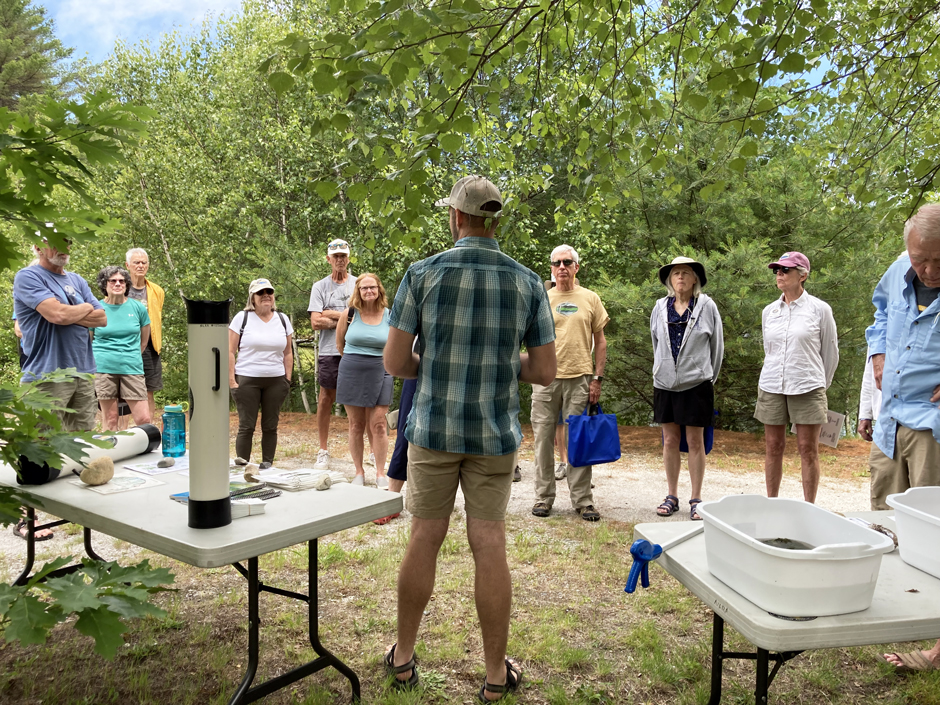
NLRA Conservation Program Manager, Paul Pellissier, leads a Weed Watcher workshop—training volunteers in aquatic plant identification, survey techniques, and how to report suspected invasive plant material. (Credit: NLRA)




0 comments